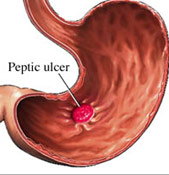


Parkinson’s (PD) Overview
 Peptic ulcers can be said, as areas in the digestive system were the gastric juices and stomach acids destroy the tissue lining.Peptic ulcer disease is a general term for ulcers that occur in the stomach, duodenum (upper part of the small intestine) and esophagus.
Peptic ulcers can be said, as areas in the digestive system were the gastric juices and stomach acids destroy the tissue lining.Peptic ulcer disease is a general term for ulcers that occur in the stomach, duodenum (upper part of the small intestine) and esophagus.An ulcer occurs when the acidic digestive juices, which are secreted by the stomach cells, corrode the lining of these organsusually defined as mucosal erosions equal to or greater than 0.5 cm.
- The mucous membrane lining the digestive tract erodes and causes a gradual breakdown of tissue.
- This breakdown causes a gnawing or burning pain in the upper middle part of the belly (abdomen).
- Although most peptic ulcers are small, they can cause a considerable amount of discomfort.
- Ulcers can occur at any age, although they are rare in children and teenagers.
- Ulcers in upper part of intestine are called as Duodenal Ulcers
- Ulcers in the stomach are called as Gastric Ulcers
- Ulcers in Esophagus are called as Esophageal ulcer
- Meckel'sDiverticulum (called Meckel'sDiverticulum ulcer)
- Duodenal ulcers are more common than Gastric Ulcers
- Duodenal ulcers usually first occur between the ages of 30-50 years and are twice as common in men as in women.
- Stomach (or gastric) ulcers usually occur in people older than 60 years and are more common in women.
What are the causes of peptic ulcer?
Top
Previously most important cause of peptic ulcer was believed to be excess acid.
- When you eat, your stomach produces hydrochloric acid and an enzyme called pepsin to digest the food.The food is partially digested in the stomach and then moves on to the duodenum to continue the process.
- Peptic ulcers occur when the acid and enzyme overcome the defense mechanisms of the gastrointestinal tract and cause erosion in the mucosal wall.
- While acid is still considered significant in ulcer formation, the leading cause of ulcer disease is currently believed to be infection of the stomach by a bacteria called "Helicobacter pyloricus" (H. pylori)
- Not everyone who gets an ulcer is infected with H pylori. We now know that aspirin and non-steroidal anti-inflammatory drugs (NSAIDs) can cause ulcers if taken regularly.
- Contrary to popular belief, alcohol, coffee, colas, spicy foods, and caffeine have no proven role in ulcer formation. Similarly, there is no conclusive evidence to suggest that life stresses or personality types contribute to ulcer disease.
- Life style disorders such as cigarette smoking, Alcohol consumption, spices cannot cause peptic ulcer but can play a major role in their development when associated with H.pylori infection.
What are the sign and symptoms of Peptic Ulcer?
Top
Peptic Ulcers do not always cause symptoms. Sometimes, a serious complication such as bleeding is the first sign of an ulcer.
The most common symptom of peptic ulcers is Abdominal pain:
The duodenum refers to the upper region of the small intestine.
Ulcers that occur in the stomach are called gastric ulcers.
The most common symptom of peptic ulcers is Abdominal pain:
- The pain is usually in the upper middle part of the abdomen, above the belly button (navel) and below the breastbone.
- The pain can feel like burning or gnawing, and it may go through to the back.
- Pain often comes several hours after a meal when the stomach is empty.
- The pain is often worse at night and early morning.
- It can last anywhere from a few minutes to several hours.
- The pain in duodenal ulcer is different than that of gastric ulcer
The duodenum refers to the upper region of the small intestine.
- Duodenal ulcers cause an aching, burning, hunger-like pain in the upper-middle portion of the abdomen, just below the breastbone.
- This pain tends to develop or worsen when the stomach is relatively empty—usually two to five hours after eating.
- The pain of duodenal ulcers usually occurs in the night, when acid secretion and production is the most rampant.
Ulcers that occur in the stomach are called gastric ulcers.
- The pain from these ulcers tends to occur immediately after eating. Gastric ulcer pain doesn't tend to respond very well to antacids and other over-the-counter medications; eating doesn't make the pain subside, but tends to exacerbate it.
- In other words, pain happens when the stomach is full—unlike duodenal ulcer pain, which occurs when the stomach is empty.
- Abdominal fullness
- Water Brash
- Heartburn, GERD
- Nausea
- Vomiting
- Loss of appetite
- Loss of weight
- Hematemesis: Very severe ulcers sometimes cause bleeding in the stomach or duodenum.
- Malena; Blood in the stool or black, tarry, sticky-looking stools
- Anaemia
How is Peptic Ulcer Diagnosed?
Top
After taking a complete history of the patient a doctor may advise the following test to confirm that you have an ulcer,
Upper GI series (UGI): It is a special type of X-ray done after giving the patient a chalky fluid to drink (barium)
Endoscopy (EGD)
Upper GI series (UGI): It is a special type of X-ray done after giving the patient a chalky fluid to drink (barium)
Endoscopy (EGD)

Peptic ulcer




